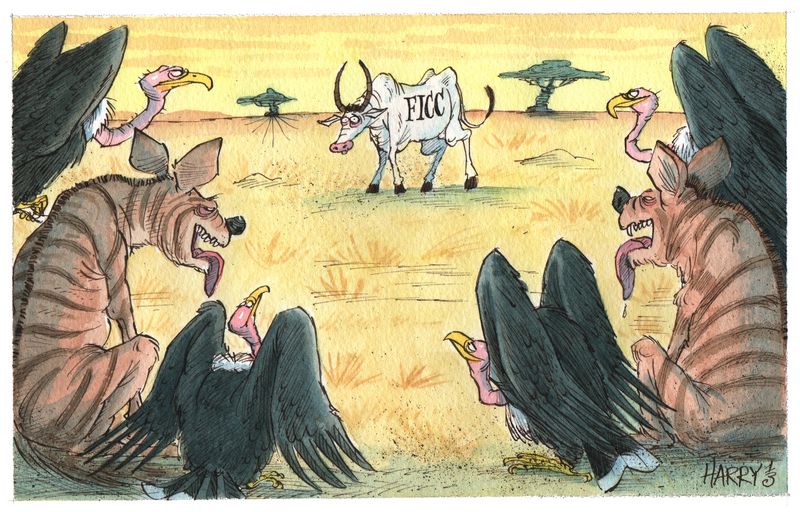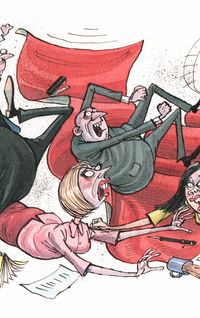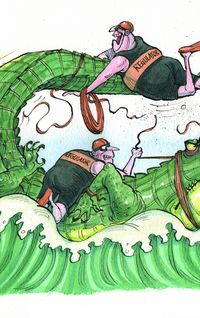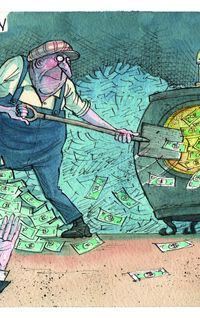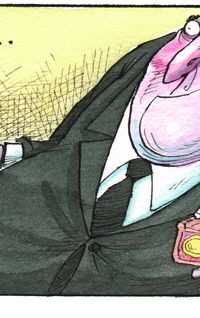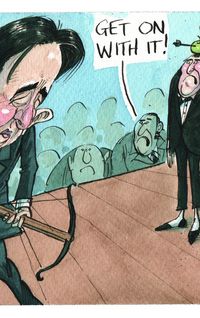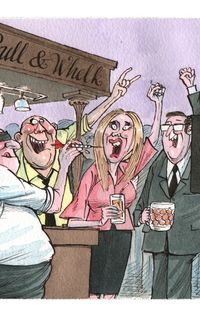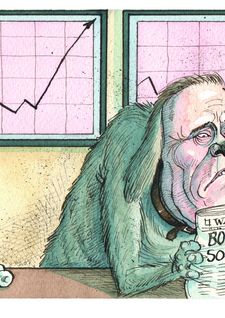+-Fixed-income, currencies and commodities units have been the banking industry’s main cash cow for years. But that looks to be coming to an end, as business heads wrestle with new capital, leverage and derivatives trading rules.
2013 is a year fixed-income traders would rather forget. After a middling first half, things came to a head in the third quarter when FICC revenues plummeted by as much as 50% compared to a year ago.
This was quite a wake-up call for a business that had grown used to producing more than half of investment banks’ revenues over the past decade. Fixed income was faced with the ignominy – perish the thought – of being propped up by equities and capital markets units, rather than the other way round.
This set off some frantic soul-searching in an industry unsure whether the fall-off was a temporary blip that could be put down to dysfunction in Washington DC and bungled communication by the Federal Reserve, or a symptom of irreversible decline brought about by increasingly stringent regulations.
“It’s been a challenging year across the industry regarding the traditionally strong fixed-income part of the business, particularly rates trading, which has dominated the industry’s recovery over the past few years following the financial crisis,” said Andres Recoder, head of markets for EMEA at Citigroup.
FICC’s day of reckoning, of course, had been telegraphed since 2008. Much of the regulation penned in response to the financial crisis, from Basel III to the US Dodd-Frank Act, is aimed squarely at its bows.
But the long lead time before implementation – Basel III does not fully hit until 2018, while the Dodd-Frank reforms only started in earnest this year – combined with an amenable trading environment in 2009 and 2010 to mask the extent of the problems lying in wait.
To help cope with the 2008 crisis, global central banks injected trillions of dollars of cash into financial markets. And that helped fixed-income desks rake in record revenues of US$131bn in 2009 – 16% more than at the height of the structured credit boom in 2006, according to UBS analysts.
But under the new Basel rules, the lucrative businesses at the heart of fixed-income trading – such as structured credit or long-dated swaps – are now to be penalised with hefty capital charges.
Along with a clampdown on proprietary trading, the framework is intended to prevent banks from racking up large trading losses that could endanger the wider system. Yet the regulations also have the effect of constraining banks from reaping huge returns during the good times.
New rules on derivatives will have a similar effect. The increase in standardisation and the need to funnel trades through clearing houses and on to exchanges now threaten to disintermediate banks, squeezing profitability as compliance costs rise and margins collapse.
“The confluence of the capital rules and the reforms around derivatives trading protocols will mean there are some pretty seismic shifts coming down the track in terms of business model,” said Chris Murphy, head of rates and credit at UBS, which has taken a more ruthless approach to slimming down its fixed-income business in response to Basel III than most of its rivals.
Blindsided by leverage
The regulatory coup de grace came in June 2013, when the Basel Committee refused to back down from a minimum 3% leverage ratio. The adoption of this US-centric metric blindsided many European firms, most of which had not paid much attention to capital versus total assets.
Traditionally the European tendency to lend directly to companies rather than underwrite financing in capital markets had left their balance sheets swollen compared with their US rivals, even if many of these assets were low-risk and equally low-yielding.
“I’m comfortable with the concept of lower leverage. The problem is that these rules might unwittingly encourage banks to retreat from government bonds and repo activity, and buy leveraged loans and inventory,” said Colin Fan, global head of markets at Deutsche Bank. “We find it hard to believe that is the outcome regulators want.”
As a result of the 3% leverage ratio, RBS analysts reckon European banks need to cut a further €2.9trn – on top of the €3.2trn of assets they shed between May 2012 and September this year – in order to shore up their capital base.
Firms with historically powerful fixed-income units are hardest hit. Deutsche Bank and Barclays announced plans to slash up to €400bn from their balance sheets between them in July, while the UK bank raised £5.95bn in fresh equity.
But it is a tough road ahead. Even though the two shed more than €100bn of assets in the third quarter, their leverage ratios remained unchanged at 2.3% and 2.2%, respectively. Other European lenders in the line of fire include Credit Suisse, which opted to scale back its rates business in October, as well as UBS and Societe Generale.
“The leverage ratio is a huge constraint, but it will have a greater impact on banks with large legacy fixed-income businesses,” said one banker. “Restructuring balance sheets always costs more money, and it makes it hard keep staff motivated.”
No more repo?
No one is expecting regulators to walk back their changes, but bankers are clamouring for some tweaks to the rules, such as allowing greater netting in repo activities as well as between derivatives and collateral.
“The repo business is the main question. We expect netting here because otherwise liquidity for government bond trading will be impacted,” said Danielle Sindzingre, global head of fixed income and currencies at Societe Generale.
Part of the problem is how the different regulations fit together.
“Even the cumulative impact of currently proposed regulations is poorly understood. The move towards central clearing creates a greater need for sourcing and financing collateral, but repo activity is pretty much the worst thing that you can do with your balance sheet under the leverage ratio,” said UBS’ Murphy.
“The focus on leverage is somewhat perversely incentivising banks to make their balance sheets more risky, not less.”
This means low-margin financing activities – such as revolving credit facilities for corporates – will either have to reprice or fall into obscurity.
So on what areas will banks focus? In terms of legacy assets, hundreds of millions of dollars worth of derivatives books have been earmarked for bilateral collapses. As regards new business, there will be an emphasis on clearing derivatives to avoid inflating balance sheets. Many are also betting heavily on electronic trading, and are piling money into new systems.
“Those that don’t embrace an electronic trading approach will struggle with the leverage ratio,” said DB’s Fan. “Our top 10 counterparties account for 60% to 70% of our derivatives volumes under CRD IV, and the vast majority of that is clearable.”
Such a move relies on robust volumes to make up for collapsing margins. However, talk of being a “flow monster” in fixed income has dissipated of late, as senior bankers focus instead on their top 50 or 100 clients.
The hope is those clients will offer enough high-margin, solutions-based business to offset the more meagre returns gleaned from flow trading, which is increasingly viewed as a way to recycle risk rather than generate profits.
“2013 has been a very challenging environment – it’s the first time in a number of years that there is no clear strategy for everyone,” said Thibaut de Roux, head of global markets for EMEA at HSBC. “Banks aren’t able to deliver every product to every customer. They need to choose what their client base is, and look to service it.”
Global powerhouses
Meanwhile many European banks are grumbling about the head start US banks have in tackling the leverage rules, as well as the uneven application across jurisdictions. Some of this is likely to be offset by US regulators’ preference for a higher ratio of up to 6%.
“Banks are being impacted in different ways, and we can still see some trends of consolidation in the FICC space as barriers to entry [and to staying] continue to rise,” said Citigroup’s Recoder. “US franchises certainly seem to be doing better during this part of the cycle.”
And for now, at least, there is a notable correlation between firms with higher leverage ratios and those with strong FICC trading results. Deutsche bank analysts singled out Citigroup, HSBC and JP Morgan in a November report as “global commercial powerhouses” with “winning business models”. Their share of FICC revenues has risen to 27% this year compared to 23% in 2012 and 17% pre-crisis. All three have leverage ratios over 4%.
So for all its current woes, fixed income has a history of confounding those who have written its obituary prematurely. The sector may be down, but it is surely too early to say it’s out.
To see the full digital edition of the IFR Review of the Year, please click here.
To purchase printed copies or a PDF of this report, please email gloria.balbastro@thomsonreuters.com
